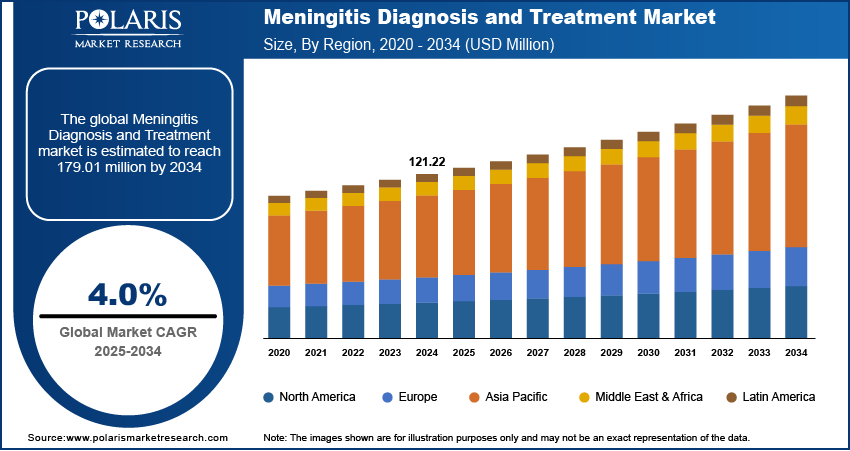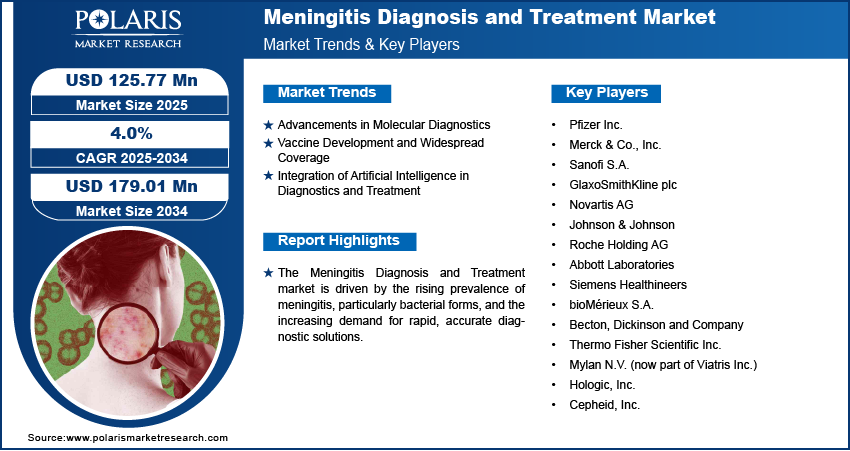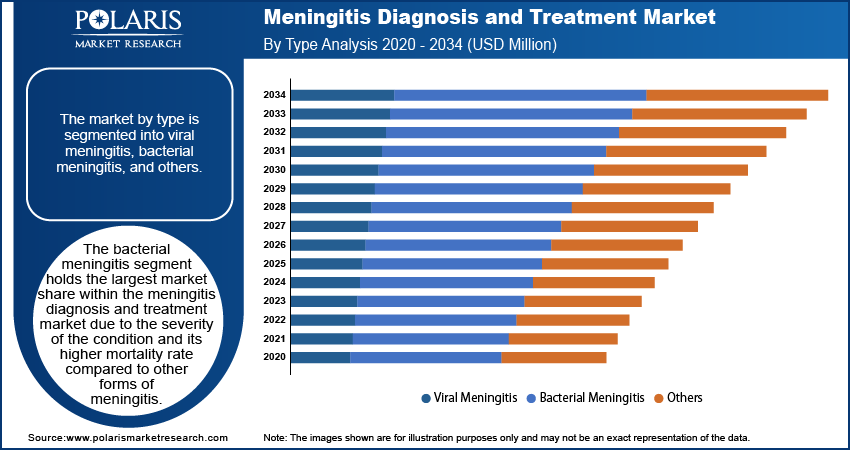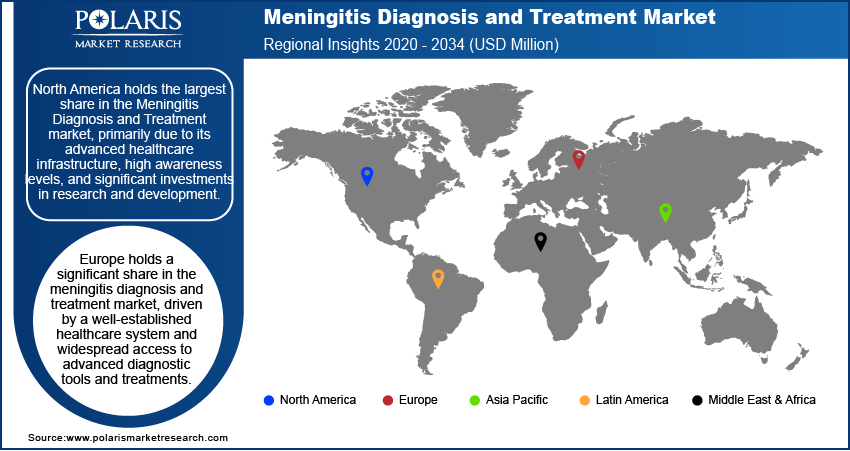
Meningitis Diagnosis and Treatment Market Size, Share, Trends, Industry Analysis Report: By Type (Viral Meningitis, Bacterial Meningitis, and Others), Treatment & Diagnosis, End User (Hospitals & Clinics and Others), and Region (North America, Europe, Asia Pacific, Latin America and Middle East & Africa) – Market Forecast, 2025–2034
- Published Date:Feb-2025
- Pages: 119
- Format: PDF
- Report ID: PM1593
- Base Year: 2024
- Historical Data: 2020-2023
Meningitis Diagnosis and Treatment Market Overview:
The meningitis diagnosis and treatment market size was valued at USD 121.22 million in 2024. The market is projected to grow from USD 125.77 million in 2025 to USD 179.01 million by 2034, exhibiting a CAGR of 4.0% during the forecast period. The meningitis diagnosis and treatment market involves the development and delivery of diagnostic tools and therapeutic solutions for meningitis, an inflammation of the membranes surrounding the brain and spinal cord. The market is driven by the increasing prevalence of meningitis, rising awareness about its early diagnosis, and advancements in medical technologies. Additionally, the growing focus on vaccine development and the demand for effective treatment options, especially for bacterial and viral forms of meningitis, are contributing to market growth. Trends such as the adoption of molecular diagnostics, improved vaccine coverage, and the rising investment in healthcare infrastructure in emerging economies are also shaping the market. The ongoing research for innovative treatments and the need for rapid diagnostic solutions further fuel meningitis diagnosis and treatment market expansion.

To Understand More About this Research: Request a Free Sample Report
Meningitis Diagnosis and Treatment Market Dynamics
Advancements in Molecular Diagnostics
The increasing use of molecular diagnostics in the meningitis diagnosis and treatment market is a significant trend. Molecular diagnostic techniques, such as PCR (Polymerase Chain Reaction), offer faster and more accurate detection of meningitis-causing pathogens, including bacterial and viral agents. These techniques allow for the identification of specific strains of pathogens, improving treatment outcomes by enabling personalized therapies. The adoption of these diagnostic tools is driven by the need for rapid and accurate detection, which is critical for early intervention and reducing mortality rates. According to a study published in the Journal of Clinical Microbiology, PCR methods can reduce diagnosis time from several days to just a few hours, making them a crucial tool in meningitis diagnosis.
Vaccine Development and Widespread Coverage
Vaccine development continues to play a pivotal role in reducing the incidence of meningitis, particularly bacterial forms, which are more severe and often result in higher mortality rates. The global introduction of vaccines targeting Neisseria meningitidis, Streptococcus pneumoniae, and Haemophilus influenzae type b has significantly lowered the burden of bacterial meningitis. The trend is now shifting toward the development of broad-spectrum vaccines that can address a wider range of pathogens. For example, the introduction of the MenB vaccine since 2015, targeting meningococcal group B, had a major impact on meningitis prevention. The World Health Organization (WHO) post the introduction of these vaccines reported that vaccination programs have reduced the incidence of bacterial meningitis by up to 90% in some regions, further highlighting the growing importance of vaccines in the global strategy to combat meningitis.
Integration of Artificial Intelligence in Diagnostics and Treatment
Artificial Intelligence (AI) and machine learning technologies are increasingly being integrated into the diagnosis and treatment of meningitis. AI-driven tools can analyze medical images and patient data to assist healthcare providers in making more accurate and timely diagnoses. Machine learning algorithms are also being used to predict treatment outcomes, personalize therapies, and identify potential drug resistance in bacterial strains. Research study Artificial Intelligence in Differential Diagnostics of Meningitis: A Nationwide Study published in 2021, applied three machine learning algorithms—multiple logistic regression (MLR), random forest (RF), and naïve-Bayes (NB)—to distinguish between bacterial and viral meningitis. The models achieved over 95% accuracy in predicting viral meningitis and 78% for bacterial meningitis. The study also reaffirmed the high diagnostic value of the cerebrospinal fluid (CSF) neutrophil-to-lymphocyte ratio (NLR) in this differentiation. A 2023 study from Nature Medicine highlighted the success of AI models in identifying meningitis-related anomalies in brain scans, underscoring its potential in revolutionizing diagnostic workflows and improving patient outcomes.

Meningitis Diagnosis and Treatment Market Segment Insights
Meningitis Diagnosis and Treatment Market Assessment by Type
The market by type is segmented into viral meningitis, bacterial meningitis, and others. The bacterial meningitis segment holds the largest market share due to the severity of the condition and its higher mortality rate compared to other forms of meningitis. The demand for rapid diagnostic solutions and effective treatments for bacterial meningitis is particularly high, as timely intervention is crucial to improving survival rates and minimizing complications. The widespread availability of vaccines targeting major bacterial strains, such as Neisseria meningitidis and Streptococcus pneumoniae, has also contributed to the segment's dominance. Despite the advancements in vaccination, bacterial meningitis remains a critical concern, driving sustained demand for diagnostic tools and treatments in this segment.
The viral meningitis segment holds a smaller share in the market. However, it is registering the highest growth due to the increasing awareness of viral infections and improved diagnostic capabilities. Advances in molecular diagnostics and enhanced public health surveillance have enabled faster detection of viral meningitis, contributing to the growth of this segment. As the incidence of viral infections continues to rise globally, including cases caused by enteroviruses, the demand for antiviral treatments and vaccines is also increasing. The rise in viral meningitis cases is further spurred by ongoing research into effective antiviral therapies and the development of vaccines targeting specific viral pathogens, leading to a higher growth rate in this segment.
Meningitis Diagnosis and Treatment Market Evaluation by Treatment & Diagnosis
The market by treatment & diagnosis is segmented into treatment and diagnosis. The treatment segment holds the largest meningitis diagnosis and treatment market share primarily due to the critical need for timely and effective interventions for meningitis patients. This segment includes a range of therapies, such as antibiotics for bacterial meningitis and antiviral treatments for viral forms, along with corticosteroids to manage inflammation. The demand for these treatments is high as timely intervention can significantly reduce mortality rates and long-term complications. Additionally, the growing focus on developing targeted treatments, such as vaccines and immunotherapies, has further contributed to the growth and sustained market share of the treatment segment.
The diagnosis segment, while vital, is registering the highest growth due to continuous advancements in diagnostic technologies. The integration of molecular diagnostics, such as PCR and other genetic tests, is revolutionizing the speed and accuracy of meningitis detection. These innovations enable healthcare providers to quickly identify pathogens, particularly in emergency settings, where time is crucial. As awareness of the importance of early diagnosis increases and healthcare systems upgrade their capabilities, the diagnosis segment is seeing accelerated growth, driven by both the rising incidence of meningitis and the adoption of advanced diagnostic methods.
Meningitis Diagnosis and Treatment Market Assessment by End User
The market by end user is segmented into hospitals & clinics and others. The hospitals and clinics segment holds the largest market share owing to the critical nature of meningitis and the need for specialized care that these facilities provide. Hospitals and clinics are the primary settings for the diagnosis and treatment of meningitis, offering advanced diagnostic tools and a broad range of therapeutic options, including emergency care for bacterial meningitis cases. The availability of skilled medical professionals, access to advanced diagnostic technologies, and the ability to manage severe cases effectively make hospitals and clinics the dominant end-user segment in the market.
The others segment, which includes diagnostic laboratories, outpatient care centers, and other healthcare facilities, is experiencing the fastest growth. This growth is driven by the increasing availability of diagnostic tools and therapies outside of traditional hospital settings. With the rising demand for more accessible healthcare services and the growing use of mobile diagnostic units and telemedicine, non-hospital healthcare providers are seeing greater adoption of meningitis diagnostic and treatment services. These developments, coupled with the expansion of healthcare infrastructure in emerging markets, are driving the rapid growth of the others segment.

Meningitis Diagnosis and Treatment Market Regional Insights
By region, the study provides meningitis diagnosis and treatment market insights into North America, Europe, Asia Pacific, Latin America, and the Middle East & Africa. North America holds the largest market share primarily due to its advanced healthcare infrastructure, high awareness levels, and significant investments in research and development. The region benefits from well-established diagnostic capabilities, access to the latest treatment options, and widespread vaccination programs, particularly for bacterial meningitis. Additionally, the presence of major pharmaceutical and biotechnology companies in North America contributes to the continuous innovation of meningitis-related therapies and diagnostic tools. High healthcare spending, along with a strong emphasis on early diagnosis and preventive care, further strengthens the region's dominance in the market.
Europe holds a significant share in the meningitis diagnosis and treatment market, driven by a well-established healthcare system and widespread access to advanced diagnostic tools and treatments. The region benefits from high vaccination rates and robust public health policies aimed at reducing meningitis cases, particularly bacterial meningitis. The growing focus on research and development, coupled with the increasing demand for rapid diagnostic technologies, has contributed to market expansion. Additionally, the presence of key healthcare players and increasing government investments in healthcare infrastructure in European countries are further boosting the market growth in the region.
Asia Pacific is experiencing rapid meningitis diagnosis and treatment market growth, fueled by the increasing incidence of meningitis and the expanding healthcare infrastructure. Countries such as China and India are seeing rising demand for diagnostic and treatment solutions, driven by population growth, urbanization, and greater healthcare access. The region’s growing focus on improving healthcare facilities, especially in rural areas, is contributing to market expansion. Moreover, the rise in awareness about meningitis prevention and the introduction of vaccination programs are expected to drive further growth in Asia Pacific market.

Meningitis Diagnosis and Treatment Market – Key Market Players and Competitive Insights
Key players in the meningitis diagnosis and treatment market include companies such as Pfizer Inc.; Merck & Co., Inc.; Sanofi S.A.; GlaxoSmithKline plc; and Novartis AG. Other significant players are Johnson & Johnson, Roche Holding AG, Abbott Laboratories, Siemens Healthineers, bioMérieux S.A., Becton, Dickinson and Company, and Thermo Fisher Scientific Inc. Companies such as Mylan N.V. (now part of Viatris Inc.); Hologic, Inc.; and Cepheid, Inc. also play a crucial role in the market with their diagnostic and therapeutic solutions. Some companies such as Moderna, Inc. are contributing to the development of mRNA-based vaccines for meningitis, pushing innovation in vaccine technology. Furthermore, emerging players such as Bio-Rad Laboratories, Inc. and Alere Inc. (now part of Abbott) continue to strengthen their presence in the market.
Competitive dynamics in the meningitis diagnosis and treatment market reflect the continuous efforts of companies to improve diagnostic accuracy and expand vaccine availability. Players are focusing on the development of advanced diagnostic tools, including PCR and molecular diagnostics, to offer quicker and more precise detection methods. Companies are also engaged in research to enhance the effectiveness of vaccines and antiviral treatments. The increasing prevalence of meningitis in both developed and developing regions is fostering competition among these firms to offer more efficient treatments and diagnostic options. Collaborations and partnerships between pharmaceutical companies and diagnostic manufacturers are common as companies seek to leverage complementary strengths to broaden their product portfolios.
In terms of market trends, there is a growing focus on the integration of artificial intelligence and machine learning in diagnostic solutions to enhance efficiency and reduce human error. Companies are also emphasizing the development of vaccines with broader coverage to protect against various strains of meningitis. This trend is seen in the efforts by major vaccine manufacturers to expand their portfolios with vaccines targeting specific pathogens causing meningitis. With the ongoing research and development, especially in mRNA-based vaccines, key players are positioning themselves to capitalize on the evolving treatment landscape, which is expected to drive future competition in the market.
Pfizer Inc. is a multinational pharmaceutical company that develops and produces medicines and vaccines, including those for meningitis. The company plays a significant role in providing vaccines such as Prevnar 13, which protects against pneumococcal meningitis, and other related therapeutic solutions. Pfizer has been actively involved in global vaccination programs and works with health authorities to improve access to its products.
GlaxoSmithKline (GSK) is another key player in the meningitis market. It focuses on developing vaccines such as Menveo and Bexsero vaccines, which protect against various strains of meningitis and help to reduce the incidence of bacterial meningitis. The company is actively working on expanding its vaccine offerings and improving treatment options for meningitis.
Key Companies in Meningitis Diagnosis and Treatment Market
- Pfizer Inc.
- Merck & Co., Inc.
- Sanofi S.A.
- GlaxoSmithKline plc
- Novartis AG
- Johnson & Johnson
- Roche Holding AG
- Abbott Laboratories
- Siemens Healthineers
- bioMérieux S.A.
- Becton, Dickinson, and Company
- Thermo Fisher Scientific Inc.
- Mylan N.V. (now part of Viatris Inc.)
- Hologic, Inc.
- Cepheid, Inc.
Meningitis Diagnosis and Treatment Market Developments
- December 2023: GSK received approval from the European Medicines Agency (EMA) for an updated version of its meningitis B vaccine aimed at improving vaccine coverage and addressing emerging strains. This approval is expected to bolster GSK's position in the meningitis vaccine market.
- August 2023: Pfizer announced the approval of its new meningitis B vaccine, which was authorized by the US FDA, expanding its portfolio to address the growing global concern of meningococcal diseases.
Meningitis Diagnosis and Treatment Market Segmentation
By Type Outlook
- Viral Meningitis
- Bacterial Meningitis
- Others
By Treatment & Diagnosis Outlook
- Treatment
- Diagnosis
By End User Outlook
- Hospitals & Clinics
- Others
By Regional Outlook
- North America
- US
- Canada
- Europe
- Germany
- France
- UK
- Italy
- Spain
- Netherlands
- Russia
- Rest of Europe
- Asia Pacific
- China
- Japan
- India
- Malaysia
- South Korea
- Indonesia
- Australia
- Vietnam
- Rest of Asia Pacific
- Middle East & Africa
- Saudi Arabia
- UAE
- Israel
- South Africa
- Rest of Middle East & Africa
- Latin America
- Mexico
- Brazil
- Argentina
- Rest of Latin America
Meningitis Diagnosis and Treatment Market Report Scope:
|
Report Attributes |
Details |
|
Market Size Value in 2024 |
USD 121.22 million |
|
Market Size Value in 2025 |
USD 125.77 million |
|
Revenue Forecast in 2034 |
USD 179.01 million |
|
CAGR |
4.0% from 2025 to 2034 |
|
Base Year |
2024 |
|
Historical Data |
2020–2023 |
|
Forecast Period |
2025–2034 |
|
Quantitative Units |
Revenue in USD million and CAGR from 2025 to 2034 |
|
Report Coverage |
Revenue Forecast, Market Competitive Landscape, Growth Factors, and Industry Trends |
|
Segments Covered |
|
|
Regional Scope |
|
|
Competitive Landscape |
|
|
Report Format |
|
|
Customization |
Report customization as per your requirements with respect to countries, regions, and segmentation. |
How is Report Valuable for an Organization?
Workflow/Innovation Strategy: The meningitis diagnosis and treatment market has been segmented into detailed segments of type, treatment & diagnosis, and end user. Moreover, the study provides the reader with a detailed understanding of the different segments at both the and regional levels.
Growth/Marketing Strategy: The growth strategy in the meningitis diagnosis and treatment market revolves around expanding product portfolios and enhancing diagnostic and treatment capabilities. Companies are increasingly focusing on developing advanced diagnostic tools, such as molecular diagnostics and AI-based systems, to improve early detection and accuracy. Additionally, key players are investing in vaccine development and expanding access to vaccines in underserved regions. Strategic partnerships and collaborations with healthcare providers, government agencies, and research institutions are also critical for market expansion. Companies are leveraging these collaborations to enhance their product offerings and increase their global market presence.
FAQ's
? The meningitis diagnosis and treatment market size was valued at USD 121.22 million in 2024 and is projected to grow to USD 179.01 million by 2034.
? The market is projected to register a CAGR of 4.0% during the forecast period 2024-2034.
? North America had the largest share of the market.
? Key players in the meningitis diagnosis and treatment market include companies such as Pfizer Inc.; Merck & Co., Inc.; Sanofi S.A.; GlaxoSmithKline plc; and Novartis AG. Other significant players are Johnson & Johnson, Roche Holding AG, Abbott Laboratories, Siemens Healthineers, bioMérieux S.A., Becton, Dickinson and Company, and Thermo Fisher Scientific Inc.
? The bacterial meningitis segment accounted for the largest share of the market.
? The treatment segment accounted for the largest share of the market.
? Meningitis diagnosis and treatment refers to the medical procedures and therapies used to identify and manage meningitis, an inflammation of the protective membranes covering the brain and spinal cord. Diagnosis typically involves the use of various tests such as lumbar puncture (spinal tap), blood tests, and molecular diagnostics to determine the cause, which could be bacterial, viral, fungal, or parasitic. Treatment varies depending on the cause of meningitis: bacterial meningitis is usually treated with antibiotics, while viral meningitis may be managed with antiviral medications and supportive care. Vaccines also play a crucial role in preventing certain types of meningitis, especially bacterial forms
? A few key meningitis diagnosis and treatment market trends are described below: Advancements in Diagnostic Technology: Increased use of molecular diagnostics and PCR-based methods for faster and more accurate detection of meningitis pathogens. Focus on Vaccine Development: Continuous efforts to develop and improve vaccines for bacterial and viral strains, including mRNA-based vaccines. Integration of Artificial Intelligence: AI applications in diagnostics to enhance accuracy and reduce time in detecting meningitis. Expansion of Vaccination Programs: Widespread adoption of vaccination strategies in both developed and emerging markets to reduce the incidence of meningitis.
? A new company entering the meningitis diagnosis and treatment market could focus on developing innovative diagnostic solutions that leverage cutting-edge technologies such as AI and molecular diagnostics to provide faster and more accurate results. Focusing on niche areas, such as developing vaccines for emerging meningitis strains or enhancing treatments for antibiotic-resistant bacterial infections, could set the company apart. Additionally, expanding access to diagnostics and treatment options in underserved regions, particularly in emerging markets, would address a significant need. Collaboration with healthcare institutions and research organizations for product development and distribution would also be beneficial in gaining a competitive edge.
? Companies manufacturing, distributing, or purchasing Meningitis Diagnosis and Treatment and related products, and other consulting firms must buy the report.
